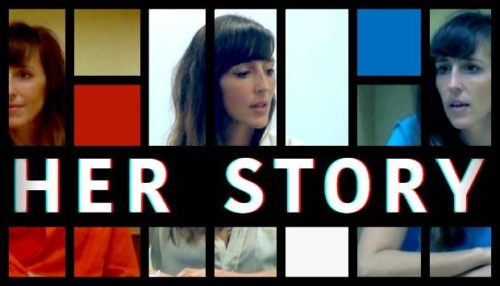Narrative in computer games
I’ve written here before about appreciating the art in computer games and discovering narrative games. Since then I have played a number of small indie games that play with storytelling in very different ways. Here are a few that have stayed with me.

It’s now two years since Tim and I played Her Story and it remains a real high point. The interface looks like an old (early 1990s) computer console and it’s supposed to be the police database files from one particular case. All you have is a search bar where the results are video clips from a suspect’s interrogation. You’re given a hint of what to search for first, which also serves as a clue to the crime that has been committed. The video clips are actual videos, starring actress Viva Seifert. The story is really well told, even in short, out-of-order clips. It touches on fairy tales, family and some pretty dark stuff. I loved this so much I insisted on finding a way to watch every single video clip, long after we’d figured out the story.
The most recent game I played, again with Tim, was A Normal Lost Phone. In this case the interface is a modern smartphone, with a handful of apps. The phone doesn’t have any credit or Wifi, but from the text messages you learn that the phone belongs to Sam, who turned 18 today and has disappeared. There is a little bit of puzzle-solving in unlocking some of Sam’s accounts, but the story is told in text and images. It’s a simple story, dealing with some complex, sometimes upsetting issues. It gets a tiny bit infomercial at one point, but for the most part is a really good game.
A more common type of narrative game is the walking simulator. In these you are a character walking through a landscape and you uncover a story. Sometimes you have minimal choices about the order in which you take the paths available, but for the most part there is only one route to take and one story to experience. Firewatch is an excellent example (with a little freedom of choice built in), while Everybody’s Gone to the Rapture is so slow that we gave up on it. Our most recent one of these was What Remains of Edith Finch. It’s beautiful, very slightly surreal and very dark. Edith Finch returns to her old family home after the death of her mother. She’s keen to understand why so many of her family died young and whether there really is a family curse. The twist in the game play is that with every family-member flashback you have to walk the character to their death. It’s deeply upsetting. But it’s also a good story, with lots of references to Norse fairy tales.
What Remains of Edith Finch is a really good example of how computer games can be closer to the experience of reading a book than watching a film – you are the main character, you literally walk in their shoes. You truly inhabit the story. It’s really wonderful to see that idea turn into so many different kinds of storytelling.